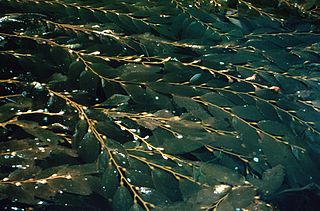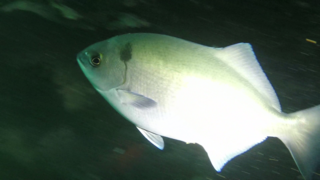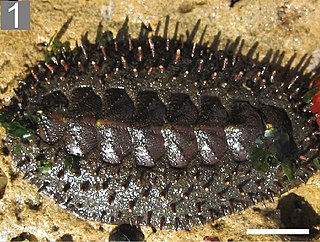
Macrocystis is a monospecific genus of kelp with all species now synonymous with Macrocystis pyrifera. It is commonly known as giant kelp or bladder kelp. This genus contains the largest of all the Phaeophyceae or brown algae. Macrocystis has pneumatocysts at the base of its blades. Sporophytes are perennial and the individual may live for up to three years; stipes/fronds within a whole individual undergo senescence, where each frond may persist for approximately 100 days. The genus is found widely in subtropical, temperate, and sub-Antarctic oceans of the Southern Hemisphere and in the northeast Pacific. Macrocystis is often a major component of temperate kelp forests.

The halfmoon, also known as the blue perch, is a species of marine ray-finned fish, a sea chub from the subfamily Scorpidinae, part of the family Kyphosidae. It is native to the coasts of the eastern Pacific Ocean off western North America. It is fished for using hook and line and it is a desirable food fish.

The redspotted catshark, also known as the Chilean catshark, is a species of catshark commonly found in the coastal waters of the southeastern Pacific, from central Peru to southern Chile. They are typically found in the rocky sublittoral areas at the edge of the continental shelf, in waters down to 100 m in depth. They spend the spring, summer, and fall in rocky subtidal areas, but winter in deeper offshore waters due to the strong currents at that time of year.

Paralabrax clathratus, the kelp bass, bull bass or calico bass, is a species of marine ray-finned fish, from the subfamily Serraninae, classified as part of the family Serranidae which includes the groupers and anthias. It is found in the eastern North Pacific Ocean where it is an important species for both recreational and commercial fisheries.

Lessonia is a genus of large kelp native to the southern Pacific Ocean. It is the only kelp to be restricted to the southern hemisphere and is primarily distributed along the coasts of South America, New Zealand, Tasmania, and the Antarctic islands. Lessonia is one of two principal genera in kelp forests.

The shrimp scad, is a species of widespread tropical marine fish of the jack family, Carangidae. The shrimp scad is widely distributed in the tropical and subtropical western Indian Ocean and areas of the eastern Pacific Ocean, ranging from South Africa in the west to Hawaii in the east, including Japan and Australia to the north and south. The species is commonly found on inshore reefs and sandy substrates. It has the common body profile of a scad, and may be difficult to differentiate from others in the genus Alepes. It is one of the larger scads, growing to 40 cm, but often is encountered at much smaller sizes. The shrimp scad often forms large schools, and is carnivorous, consuming a variety of crustaceans and small fish. It is of moderate importance to fisheries throughout its range.

The quillback rockfish, also known as the quillback seaperch, is a species of marine ray-finned fish belonging to the subfamily Sebastinae, the rockfishes, part of the family Scorpaenidae. This species primarily dwells in salt water reefs. The average adult weighs 2–7 pounds and may reach 1 m in length. Quillback rockfish are named for the sharp, venomous quills or spines on the dorsal fin. Their mottled orange-brown coloring allows them to blend in with rocky bottom reefs. The quillback rockfish eats mainly crustaceans, but will also eat herring. They are solitary and minimally migratory, but not territorial, and give birth to live young (viviparous). They are a popular sport fish, generally caught in cold water 41–60 m deep, but also to subtidal depths of 275 m.

Oxyjulis californica is a species of wrasse native to the eastern Pacific Ocean along the coasts of California and Baja California. Its distribution extends from Salt Point in Sonoma County, California, to southern central Baja California, near Cedros Island. It is a very common species; its common name in Spanish is señorita.

Graus nigra is a species of ray-finned fish endemic to the Pacific coast of South America, ranging from Valdivia in Chile to southern Peru. This species grows to a total length of 64.6 cm (25.4 in) and is popular as a game fish. This species is the only known member of its genus, and is known locally as vieja negra.

Girella nigricans, commonly known as the opaleye or rudderfish, is a species of sea chub found in the Eastern Pacific, from California to southern Baja California. A rarely documented isolated population also exists in the Gulf of California, which might be genetically different from the rest of the species. They are commonly found in shallow waters and intertidal zones, usually over rocks and kelp beds, at depths of 1 to 32 m. They feed primarily on algae, but will occasionally consume sessile invertebrates. They are considered commercially important game fish.

Chirodactylus variegatus, the Peruvian morwong or bilagai, is a species of marine ray-finned fish traditionally regarded as belonging to the family Cheilodactylidae, the members of which are commonly known as morwongs. It is found in the southeastern Pacific Ocean off the western coast of South America.

Tetrapygus is a genus of sea urchins in the family Arbaciidae. It is a monotypic genus and the only species is Tetrapygus niger which was first described by the Chilean naturalist Juan Ignacio Molina in 1782. It is found in the southeastern Pacific Ocean on the coasts of South America.
Lessonia trabeculata is a species of kelp, a brown alga in the genus Lessonia. It grows subtidally off the coasts of Peru and northern and central Chile, with the closely related Lessonia nigrescens tending to form a separate zone intertidally. Lessonia trabeculata kelp have gained a great economic importance for alginate production, and its harvest has greatly intensified along the Chilean coast during past two decades

Semicossyphus darwini is a species of ray-finned fish native to the tropical eastern Pacific Ocean. Common names include the Chilean sheepshead wrasse, the goldspot sheepshead or the Galapagos sheepshead wrasse.

Pinguipes chilensis, commonly known as the Chilean sandperch, is a species of ray-finned fish in the family Pinguipedidae. It is found in the southeastern Pacific Ocean off the coasts of Peru and Chile.

Enoplochiton echinatus is a Southeast Pacific species of edible chiton, a marine polyplacophoran mollusc in the family Chitonidae, the typical chitons.

Doryteuthis gahi, also known as Loligo, the Patagonian longfin squid and Patagonian squid, is a small-sized squid belonging to the family Loliginidae. It occurs in coastal waters in the southeastern Pacific Ocean and the southwestern Atlantic Ocean where it is caught and eaten for food.

Girella zebra, also known as zebrafish or stripey bream, is a species of marine ray-finned fish, a sea chub in the family Kyphosidae. It lives in the Indo-Pacific, where it is endemic to the coastal waters of the southern parts of Australia.

Aplodactylus punctatus, the Zamba marblefish, is a species of marine ray finned fish, one of the marblefishes belonging to the family Aplodactylidae. It is found in the eastern Pacific Ocean of the west coast of South America.

The Hawaiian chub, also known as the insular rudderfish or bicolor chub, is a species of marine ray-finned fish, a sea chub belonging to the family Kyphosidae. This species is found in the Central Pacific Ocean.


















